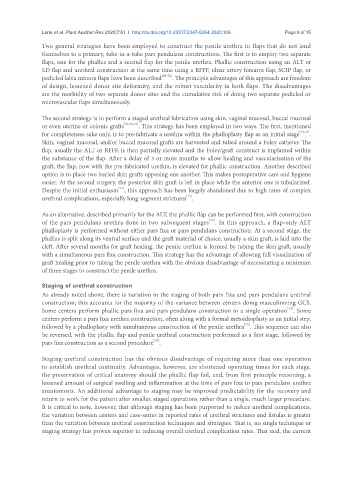Page 593 - Read Online
P. 593
Lane et al. Plast Aesthet Res 2020;7:51 I http://dx.doi.org/10.20517/2347-9264.2020.106 Page 9 of 15
Two general strategies have been employed to construct the penile urethra in flaps that do not lend
themselves to a primary, tube-in-a-tube pars pendulans constructions. The first is to employ two separate
flaps, one for the phallus and a second flap for the penile urethra. Phallic construction using an ALT or
LD flap and urethral construction at the same time using a RFFF, ulnar artery forearm flap, SCIP flap, or
pedicled labia minora flaps have been described [69-72] . The principle advantages of this approach are freedom
of design, lessened donor site deformity, and the robust vascularity in both flaps. The disadvantages
are the morbidity of two separate donor sites and the cumulative risk of doing two separate pedicled or
microvascular flaps simultaneously.
The second strategy is to perform a staged urethral fabrication using skin, vaginal mucosal, buccal mucosal
or even uterine or colonic grafts [21,73,74] . This strategy has been employed in two ways. The first, mentioned
for completeness sake only, is to pre-fabricate a urethra within the phalloplasty flap as an initial stage [73,74] .
Skin, vaginal mucosal, and/or buccal mucosal grafts are harvested and tubed around a Foley catheter. The
flap, usually the ALT or RFFF, is then partially elevated and the Foley/graft construct is implanted within
the substance of the flap. After a delay of 3 or more months to allow healing and vascularization of the
graft, the flap, now with the pre-fabricated urethra, is elevated for phallic construction. Another described
option is to place two buried skin grafts opposing one another. This makes postoperative care and hygiene
easier. At the second surgery, the posterior skin graft is left in place while the anterior one is tubularized.
[71]
Despite the initial enthusiasm , this approach has been largely abandoned due to high rates of complex
[71]
urethral complications, especially long-segment strictures .
As an alternative, described primarily for the ALT, the phallic flap can be performed first, with construction
[75]
of the pars pendulans urethra done in two subsequent stages . In this approach, a flap-only ALT
phalloplasty is performed without either pars fixa or pars pendulans construction. At a second stage, the
phallus is split along its ventral surface and the graft material of choice, usually a skin graft, is laid into the
cleft. After several months for graft healing, the penile urethra is formed by tubing the skin graft, usually
with a simultaneous pars fixa construction. This strategy has the advantage of allowing full visualization of
graft healing prior to tubing the penile urethra with the obvious disadvantage of necessitating a minimum
of three stages to construct the penile urethra.
Staging of urethral construction
As already noted above, there is variation in the staging of both pars fixa and pars pendulans urethral
construction; this accounts for the majority of the variance between centers doing masculinizing GCS.
[19]
Some centers perform phallic pars fixa and pars pendulans construction in a single operation . Some
centers perform a pars fixa urethra construction, often along with a formal metoidioplasty as an initial step,
followed by a phalloplasty with simultaneous construction of the penile urethra . This sequence can also
[75]
be reversed, with the phallic flap and penile urethral construction performed as a first stage, followed by
pars fixa construction as a second procedure .
[75]
Staging urethral construction has the obvious disadvantage of requiring more than one operation
to establish urethral continuity. Advantages, however, are shortened operating times for each stage,
the preservation of critical anatomy should the phallic flap fail, and, from first principle reasoning, a
lessened amount of surgical swelling and inflammation at the time of pars fixa to pars pendulans urethra
anastomosis. An additional advantage to staging may be improved predictability for the recovery and
return to work for the patient after smaller, staged operations rather than a single, much larger procedure.
It is critical to note, however, that although staging has been purported to reduce urethral complications,
the variation between centers and case-series in reported rates of urethral strictures and fistulas is greater
than the variation between urethral construction techniques and strategies. That is, no single technique or
staging strategy has proven superior in reducing overall urethral complication rates. That said, the current

